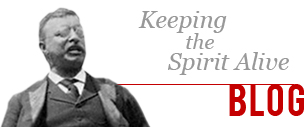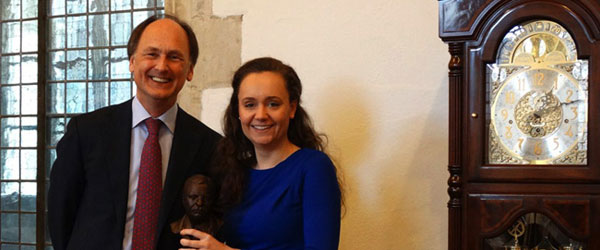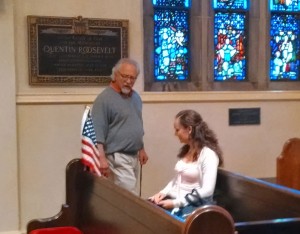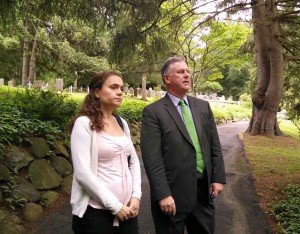It was such an honor, but perhaps an even greater surprise, to be the recipient of the Theodore Roosevelt American History Award 2014, which included a trip to New York State. I had, previously to winning the award in March 2014, no idea that to win meant to travel, and to travel seemed a coincidentally appropriate price for an MA thesis on travel writing. Writing this report about my travels and experiences leaves me with the uncanny feeling of having figuratively come full circle.
Because I had to plan my trip to New York State in June rather than later in the year as previous winners did, my itinerary looked somewhat different than usual. For example, I did not visit Theodore Roosevelt’s birthplace in New York City, but instead spent a few days in beautiful Oyster Bay at the North coast of Long Island. I was told that as T.R. did not like NYC very much, it was probably most appropriate anyway to become acquainted with this boisterous president in the town he loved and called his home. It is in Oyster Bay where he built Sagamore Hill; the estate that would be his and Edith Kermit Carow’s family home and would become known as the Summer White House during his time in office from 1901 to 1909. Unfortunately, the house was closed due to renovations, and I was therefore unable to visit Sagamore Hill.
However, a beautiful park open to the public surrounds the house and on these grounds I had the privilege to attend a sneak preview of a new documentary by Ken Burns, The Roosevelts: An Intimate History, which aims to put Theodore, Franklin, and Eleanor Roosevelt into their complex family history and connections. Careful research and obvious talent for filmmaking and scriptwriting produced a wonderfully informative and entertaining seven series documentary on the Roosevelts in relation to age-old themes such as citizenship, government, leadership, and the influences of one’s character and childhood on the course of one’s life. Earlier that day, I had already visited T.R.’s grave and the church he attended as an adult. It was, however, this documentary that gave me a glimpse of T.R.’s importance as a president and of the ways in which his presidency shaped twentieth-century America. I learned that as a Progressive he interpreted the constitution differently than his predecessors and that he rewrote the role of government in American daily life.
The following day, the Theodore Roosevelt Association awarded the Police Awards for Nassau & Suffolk County to two policemen who have admirably overcome serious physical setbacks. T.R. served as the New York City Police Commissioner and always respected and admired the police. Additionally, T.R. was a sickly child and suffered from asthma, which he overcame when he grew older due to a rigorous training program. For these reasons, this award is named after him.
My stay in Oyster Bay was concluded with a tour of the Theodore Roosevelt Museum. I had the privilege to be shown around the museum by Howard Ehrlich, a professor of history at St. John’s University and a federal ranger at Sagamore Hill. It was wonderful to be able to ask him all sorts of questions and enjoy his vast amount of knowledge of T.R. and his times. It was great to see T.R.’s original rough riders’ uniform in the Museum, which, according to professor Ehrlich, is the same kind of uniform the Boers wore during the Boer Wars in South Africa.
After this educational lesson on T.R. and his times, the focus of my trip shifted to Franklin and Eleanor Roosevelt and I drove alongside the Hudson River up to Hyde Park. It is beautiful countryside up there and it is not difficult to imagine large Dutch ships sailing up this river and its crew deciding that this area seemed like an excellent place to settle. Weather wise it reminded me of the Netherlands and perhaps this made the Dutch settlers feel at home. Also the names of many towns and streets in the area remind the visitor of the early presence of Dutch colonists.
The visit to Hyde Park entailed a visit to all the F.D.R. and E.R. related sites that are there. These include F.D.R.’s childhood home Springwood; Val-Kill, the house he built for Eleanor; Top Cottage, F.D.R.’s own little place; the Vanderbilt mansion; and, of course, the Franklin D. Roosevelt Library and Museum. As all these places have their own quaint characteristics and remarkable stories, I would like to focus here on the two sites that interested me most, the museum and Val-Kill.
It was unfortunate that I had to visit the museum without a tour guide, but the information provided to the visitor there was extensive, which made it an educational experience. Beforehand, I was already curious about the man who guided the U.S. through the Great Depression and World War II, and who is considered by many as America’s most influential president of the twentieth century. Also, his wife Eleanor Roosevelt sparked my interest as a student of women’s history. I was not disappointed and left the museum with a great sense of respect for this couple that worked together so diligently to achieve their personal ambitions and to see their ideals and visions for a nation in turmoil come to pass despite personal setbacks.
Prior to my visit to Hyde Park, I was unaware of the immense influence of F.D.R.’s presidency on American history. The reforms that he and Eleanor both worked to implement during the 1930s and 40s, albeit in their own spheres of influence—F.D.R. as the president and Eleanor as first lady, activist, author of the popular column ‘My Day’, and most importantly as F.D.R’s wife—significantly altered the face of America. F.D.R. was able to introduce reforms in practically every area of life, including labor reforms, financial reforms, and rural reforms. He brought about an enormous revision of the way in which the U.S. had so far been governed and structured, and the people were grateful and rewarded him with four consecutive terms in office.
Much like his distant cousin T.R., F.D.R. interpreted the American constitution somewhat differently than had been done before to pursue and achieve his moral and ethical ideals. These were mostly directed towards social and economical equality, even though women and non-whites were not included in this. Of course, during F.D.R.’s presidency women’s conditions had bettered and women had procured the vote. Nevertheless, Eleanor, who was a women’s rights activist, worked for bettering social conditions, children’s rights, and labor rights during her years as first lady. Less popular, in the eyes of her husband, the government, and the white population, were her efforts for African American civil rights, but despite death treats she voiced unabashed and fearlessly her support for equal rights.
Val-Kill was built especially for Eleanor Roosevelt, and it was the place where she could relax and meet with friends and family. Apparently her house was always buzzing with guests to the despair of several cooks, who never knew who or how many to expect for lunch. It was here that John F. Kennedy met with Eleanor to persuade her to endorse him for president; he needed her support for a successful campaign, which indicates her powerful position within the Democratic Party. Eleanor had previously refused to give her support, because she felt he did not take a strong enough stand on Civil Rights. Another remarkable detail about Val-Kill is that the living room’s furniture does not match and seems to be put together randomly. I was told that Eleanor Roosevelt thought that, as all her friends were so different in personality and physical appearance, her furniture needed to offer them a choice that would fit with both.
This trip was an educational experience and I thoroughly appreciated the opportunity to become acquainted with the Roosevelts, a family that so obviously played a major role in the history of the U.S.A. On the sly, I enjoyed looking for and discovering little indicators of Dutch history on Long Island and in the Roosevelt family, like the Dutch seventeenth-century Bible that was used when F.D.R. was sworn in as president. Apparently, he has been the only president of the U.S.A. to choose for this purpose a Bible in another language than English. I would like conclude with a major thank you to the Roosevelt Study Center, the Theodore Roosevelt Association, and the Roosevelt Institute for making this trip possible!









